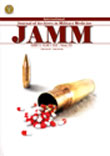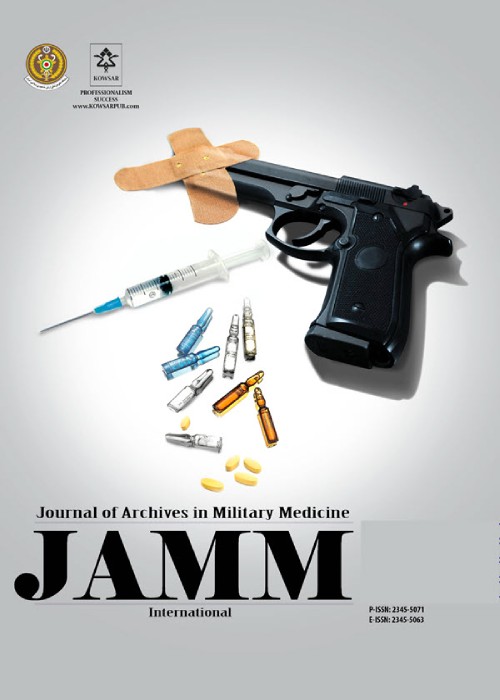فهرست مطالب

Journal of Archives in Military Medicine
Volume:4 Issue: 1, Feb 2016
- تاریخ انتشار: 1395/02/12
- تعداد عناوین: 6
-
Page 2Context: Health-related quality of life (HRQoL) is increasingly important in the assessment of chronic conditions, especially for irritable bowel syndrome (IBS), which has no associated mortality, but is prevalent and significantly impacts patients lives. Disease-specific instruments such as the irritable bowel syndrome quality of life instrument (IBS-QOL), in addition to generic instruments such as the short form (SF)-36, are useful in measuring health-related quality of life, and have been shown to be reliable in assessing disease severity and as an endpoint to monitor treatment response. We reviewed the impact of IBS on patients HRQoL, the factors causing HRQoL impairments, and the utility of HRQoL instruments in the assessment of IBS..
Evidence Acquisition: We performed electronic literature searches in Medline, the Cochrane library, and digestive disease week (DDW) meeting abstracts. Across all databases searched, common keywords included Irritable bowel syndrome, Quality of life and Health related quality of life. For databases that accommodated Boolean searches, terms specifically related to QOL and military were added..ResultsWe summarized the data available in the literature to show that HRQoL is poorer in patients with IBS compared to healthy controls, and compared to most serious chronic conditions. There are several factors that contribute to HRQoL impairments in IBS, of which gastrointestinal symptoms, physical co-morbidities, psychosocial factors and demographics all play significant roles..ConclusionsIt is crucial for clinicians to be aware of the importance of measuring HRQoL. Understanding the factors causing impairment of HRQoL is also important for clinicians seeing these patients as it helps to individualise treatment and treat the patient more holistically, to achieve greater patient satisfaction..Keywords: Irritable Bowel Syndrome, Health, Related Quality of Life -
Page 3BackgroundOral and dental care is very important for submarine crews, as they live in confined spaces while they are on their missions. If emergency dental conditions occur during submarine operations, dentistry services are not available..ObjectivesThe objective of the current study was to evaluate the prevalence of oral and maxillofacial diseases among submarine personnel..Materials And MethodsIn this cross-sectional study, 74 submarine crew and 28 marine personnel participated after signing a written informed consent statement. The data was collected using a questionnaire that included items on the demographic data, medical and dental history, behaviors related to oral and dental health, and the probability of emergency dental conditions on the mission. The questionnaire was filled out for each participant by a dentist after performing clinical and paraclinical assessments. The data were analyzed using SPSS version 20..ResultsThe DMFT index (decayed, missing, and filled teeth) for the submarine and marine groups were 5.24 ± 4.16 and 8 ± 5.94, respectively. The number of missing teeth and the MDFT index were significantly higher in the marine group (P 0.05). Prevalence of the aphthous stomatitis was significantly higher in the submarine group (PConclusionsIn general, the oral and dental health status of the submarine crew was better than that of the marine group. The prevalence of aphthous stomatitis, however, was significantly higher in the submarine group. One of the etiologies considered for that condition is stress..Keywords: Aphthous Stomatitis, Oral Hygiene, Submarine Medicine, Temporomandibular Joint
-
Page 4BackgroundChanges in the environment and living conditions are associated with changes in physical and cognitive functions..ObjectivesThe aim of this study was to examine the effects of a two-month military service period on soldiers general health, social physique anxiety, and body mass index.Materials And MethodsThe sample included all soldiers in Isfahans army garrison training period. A 28-item questionnaire on general health, a social physique anxiety questionnaire (Hart et al. 1989) that measured the social physical anxiety and the ratio of weight to the height square calculating body mass index..ResultsThe results of the paired t-test showed that there were significant differences in pre-test and post-test scores on the general health aspects of anxiety and social physique anxiety and there were no significant differences in other aspects of soldiers general health and body mass index. This suggests that the two-month training period affects only the variables of anxiety (anxiety, insomnia, and social physique anxiety)..ConclusionsThe findings showed that the military training period can significantly affect anxiety, but it cannot affect the health and body mass index..Keywords: General Health, Social Physique Anxiety, Body Mass Index, Armed Forces
-
Page 5BackgroundAlopecia areata (AA) is a common disease in the military population; however, a few studies have calculated the lifetime risk of alopecia areata in first-degree relatives of patients as well as the impact of stress..ObjectivesThe primary aim of this study was to calculate the lifetime risk of alopecia areata in first-degree relatives of index patients. The secondary aim of this study was to assess the role of stressful events in the onset/recurrence of disease..
Patients andMethodsOne hundred and twenty-one patients with alopecia areata and their first-degree relatives, which included 597 subjects in addition to 119 controls, were studied. We considered a gender and age-matched control for each patient. They were investigated for the occurrence of stressful events within the previous six months before the onset/recurrence of the disease..ResultsMore than twenty-six percent of patients had a positive family history, while 6.4 percent of first-degree relatives were affected by alopecia areata. Lifetime risks were estimated at 7.6% for parents, 9.9% for siblings, and 6.4% for children. Eighty-eight patients (73.9%) experienced stressful events within six months prior to the onset or recurrences of alopecia areata, while 32 subjects (26.9%) of the control group reported such events in the last six months (P value = 0.000)..ConclusionsCalculated lifetime risks can be used in genetic counseling. It appears that stressful events can be considered to be contributing factors in the development of alopecia areata. Also, according to our results, the role of stress in the recurrence of alopecia areata is more prominent than the primary development of the disease..Keywords: Alopecia Areata, Lifetime Risk, Stressful Event


